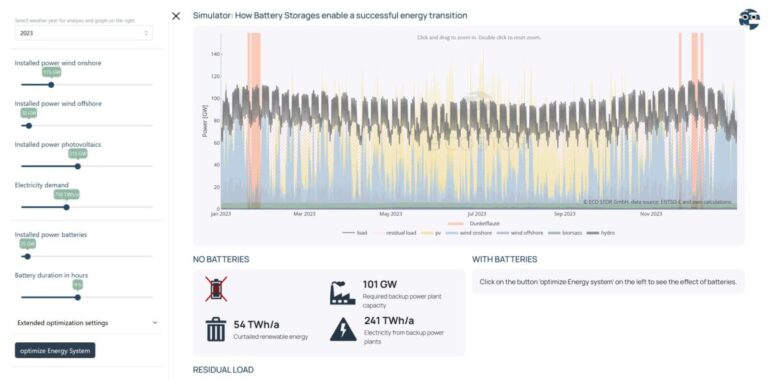The calculator on the Eco Stor website can be used to determine how great the need for storage and backup power stations will be as the energy transition progresses.
Source: https://dashboards.eco-stor.de/dunkelflaute
If the energy transition in Germany is to succeed, storage will be necessary. There is broad agreement on this, but the question is how much storage capacity we need and which additional backup power stations are needed. Eco Stor has developed an online tool for this. This allows everyone to review future models and scenarios and determine the required storage capacity. It is now available to the general public for free.
Eco Stor’s online tool is a ‘storage dashboard’ that allows simulating different future expansion scenarios based on real load and generation data. The main purpose is to show how much spare capacity will still be needed for the remaining ‘Dunkelflaute’ or ‘dark doldrums’. The phases in which neither the sun shines nor the wind blows are seen as a bogeyman for the energy transition.
The dark doldrums, also called the dark silence, is defined as a continuous period of more than 24 hours in which the input of renewable energy is permanently below the threshold of 50% of the electricity demand. Such times when less than half of the electricity demand is covered by photovoltaic solar energy and wind energy mainly occur in the winter months.
Using the online calculator speaks for itself, according to Eco Stor. There is also an online helper available that provides information on the most important steps.
The basis for generating the most realistic assumptions is the generation and consumption data from 2020 to 2023. Based on these initial values, you can then select how much photovoltaic or wind energy will be installed in the future. Assumptions can also be made about how much storage capacity is available in the short term or about electricity consumption. The result then shows the remaining supply gap and how many backup power stations are needed in the event of an emergency. The modeling is based on certain simplifications, Eco Stor notes. No account is taken of regional network bottlenecks or cross-border trade in electricity. The latter in particular is likely to replace a number of short- and long-term storage needs in the future.
Overall, the tool can provide guidance on how to further develop the energy system in the future so that short-term storage correlates with an increasing share of PV and wind energy. Eco Stor can also be used to ensure that the energy transition is carried out cost-effectively in the long term, i.e. that an electricity system can be implemented in an economically optimized manner. The real core question, Eco Stor emphasizes, is how we can achieve a CO2-free electricity supply at minimal costs.
This content is copyrighted and may not be reused. If you would like to collaborate with us and reuse some of our content, please contact: editors@pv-magazine.com.


